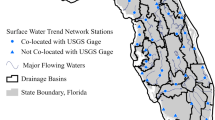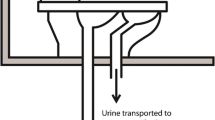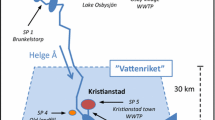Abstract
Current wastewater treatment technologies do not remove many unregulated hydrophilic compounds, and there is growing interest that low levels of these compounds, referred to as emerging contaminants, may impact human health and the environment. A probabilistic-designed monitoring network was employed to infer the extent of Florida’s ambient freshwaters containing the wastewater (Includes reuse water, septic systems leachate, and wastewater treatment effluent.) indicators sucralose, acetaminophen, carbamazepine, and primidone and those containing the widely used pesticide imidacloprid. Extent estimates with 95% confidence bounds are provided for canals, rivers, streams, small and large lakes, and unconfined aquifers containing ultra-trace concentrations of these compounds as based on analyses of 2015 sample surveys utilizing 528 sites. Sucralose is estimated to occur in greater than 50% of the canal, river, stream, and large lake resource extents. The pharmaceuticals acetaminophen, carbamazepine, and primidone are most prevalent in rivers, with approximately 30% of river kilometers estimated to contain at least one of these compounds. Imidacloprid is estimated to occur in 50% or greater of the canal and river resource extents, and it is the only compound found to exceed published toxicity or environmental effects standards. Geospatial analyses show sucralose detection frequencies within Florida’s drainage basins to be significantly related to the percentage of urban land use (R2 = 0.36, p < 0.001), and imidacloprid detection frequencies to be significantly related to the percentage of urban and agricultural land use (R2 = 0.47, p < 0.001). The extent of the presence of these compounds highlights the need for additional emerging contaminant studies especially those examining effects on aquatic biota.









Similar content being viewed by others
Notes
I = value not quantifiable by analysis method, between the MDL and PQL.
References
Anderson, J. C., Dubetz, C., & Palace, V. P. (2015). Neonicotinoids in the Canadian aquatic environment: a literature review on current use products with a focus on fate, exposure, and biological effects. Science of the Total Environment, 505, 409–422. https://doi.org/10.1016/j.scitotenv.2014.09.090.
Barnes, K., Kolpin, D., Furlong, E., Zaugg, S., Meyer, M., & Barber, L. (2008). A national reconnaissance of pharmaceuticals and organic wastewater contaminants in the United States—I. Groundwater. Science of the Total Environment, 402, 192–200. https://doi.org/10.1016/j.scitotenv.2008.04.028.
Batt, A. L., Kincaid, T. M., Kostich, M., Lazorchak, J. M., & Olsen, A. R. (2016). Evaluating the extent of pharmaceuticals in surface waters of the United States using a National-scale Rivers and Streams Assessment survey. Environmental Toxicology and Chemistry, 35, 874–881. https://doi.org/10.1002/etc.3161.
Berner, L., & Pescador, M. L. (1988). The mayflies of Florida. Gainesville: University Presses of Florida http://ufdc.ufl.edu/UF00000183/00001.
Bivand, R. S., Pebesma, E. J., & Gómez-Rubio, V. (2008). Applied spatial data analysis with R (Vol. 747248717). New York City: Springer. https://doi.org/10.1007/978-0-387-78171-6.
Bonmatin, J. M., Giorio, C., Girolami, V., Goulson, D., Kreutzweiser, D. P., Krupke, C., Liess, M., Long, E., Marzaro, M., Mitchell, D. A., Simon-Delso, N., & Tapparo, A. (2015). Environmental fate and exposure: neonicotinoids and fipronil. Environmental Science and Pollution Research, 22, 35–67. https://doi.org/10.1007/s11356-014-3332-7.
Bradley, P. M., Journey, C. A., Button, D. T., Carlisle, D. M., Clark, J. M., Mahler, B. J., Nakagaki, N., Qi, S. L., Waite, I. R., & Van Metre, P. C. (2016). Metformin and other pharmaceuticals widespread in wadeable streams of the southeastern United States. Environmental Science & Technology Letters, 3, 243–249. https://doi.org/10.1021/acs.estlett.6b00170.
Bradley, P. M., Journey, C. A., Romanok, K. M., Barber, L. B., Buxton, H. T., Foreman, W. T., Furlong, E. T., Glassmeyer, S. T., Hladik, M. L., Iwanowicz, L. R., Jones, D. K., Kolpin, D. W., Kuivila, K. M., Loftin, K. A., Mills, M. A., Meyer, M. T., Orlando, J. L., Reilly, T. J., Smalling, K. L., & Villeneuve, D. L. (2017). Expanded target-chemical analysis reveals extensive mixed-organic-contaminant exposure in U.S. streams. Environmental Science and Technology. https://doi.org/10.1021/acs.est.7b00012.
Bu, Q., Shi, X., Yu, G., Huang, J., & Wang, B. (2016). Assessing the persistence of pharmaceuticals in the aquatic environment: challenges and needs. Emerging Contaminants, 2, 145–147. https://doi.org/10.1016/j.emcon.2016.05.003.
Copeland R. E., Upchurch S. B., Summers, K., Janicki, T., Hansard P., Paulic M., Maddox G., Silvanima J., & Craig P. (1999). Florida Department of Environmental Protection’s integrated water resource monitoring efforts and the design plan of the Status Network, Florida Department of Environmental Protection Division of Water Facilities Report, 17 pp.
Drewes, J. E., Heberer, T., & Reddersen, K. (2002). Fate of pharmaceuticals during indirect potable reuse. Water Science and Technology, 46(3), 73–80 http://wst.iwaponline.com/content/46/3/73.
FDEP (Florida Department of Environmental Protection). (2008). Emerging substances of concern (white paper). https://floridadep.gov/sites/default/files/esoc_fdep_report_12_8_08.pdf. Accessed 23 May 2018.
FDEP (Florida Department of Environmental Protection). (2015). Florida Watershed Monitoring Status and Trend Program design document, technical document, Division of Environmental Assessment and Restoration, Watershed Monitoring Section. http://publicfiles.dep.state.fl.us/dear/Watershed Monitoring/Documents/WMS-MonitoringDesignDocument2015.pdf. Accessed 23 May 2018.
FDEP (Florida Department of Environmental Protection). (2016a). Quality manual for state of Florida Department of Environmental Protection Water Quality Assessment Program Watershed Monitoring Section, technical document, Division of Environmental Assessment and Restoration, Watershed Monitoring Section. June 2016. http://publicfiles.dep.state.fl.us/dear/Watershed Monitoring/Documents/WMS-QualityManual2016.pdf. Accessed 23 May 2018.
FDEP (Florida Department of Environmental Protection). (2016b). Status and Trend Monitoring Networks sampling manual, technical document, Division of Environmental Assessment and Restoration, Watershed Monitoring Section. January 2016. http://publicfiles.dep.state.fl.us/dear/watershed monitoring/documents/WMS-SamplingManual.pdf. Accessed 23 May 2018.
FDOT (Florida Department of Transportation). (1999). Florida land use, cover, and forms classification system. http://www.fdot.gov/geospatial/documentsandpubs/fluccmanual1999.pdf. Accessed 23 May 2018.
Fitzpatrick T., Lin L., & Chandrasekhar T. M. (2015). Florida Department of Environmental Protection. Procedure and policy for demonstration of capability for methods, instruments and laboratory staff. SOP LB-007. ftp://ftp.dep.state.fl.us/pub/labs/lds/sops/6889.pdf. Accessed 23 May 2018.
Florida Administrative Code. (n.d.). Chapter 62–160, Quality assurance. https://www.flrules.org/gateway/ChapterHome.asp?Chapter=62-160. Accessed 23 May 2018.
Goulson, D. (2013, 2013). An overview of the environmental risks posed by neonicotinoid insecticides. Journal of Applied Ecology. https://doi.org/10.1111/1365-2664.12111.
Grice, H. C., & Goldsmith, L. A. (2000). Sucralose—an overview of the toxicity data. Food and Chemical Toxicology, 38(Suppl. 2), S1–S6 https://www.ncbi.nlm.nih.gov/pubmed/10882813.
Hladik, M. L., & Koplin, D. W. (2015). First national-scale reconnaissance of neonicotinoid insecticides in streams across the USA. Environmental Chemistry, 13, 12. https://doi.org/10.1071/EN15061.
Hladik, M. L., Main, A. R., & Goulson, D. (2018). Environmental risks and challenges associated with neonicotinoid insecticides. Environmental Science & Technology, 52, 3329–3335. https://doi.org/10.1021/acs.est.7b06388.
Jenner, M. R., & Smithson, A. (1989). Physicochemical properties of the sweetener sucralose. Journal of Food Science, 54, 1646–1649. https://doi.org/10.1111/j.1365-2621.1989.tb05179.x.
Journey, C. E., Van Meter, P. C., Bell, A. H., Garrett, J. D., Button, D. T., Nakagaki, N., Qi, S. L., & Bradley, P. M. (2015). Design and methods of the Southeast Stream Quality Assessment (SESQA), 2014. U.S. Department of the Interior, U.S. Geological Survey, National Water-Quality Assessment Program Open-File Report 2015–1095. https://pubs.er.usgs.gov/publication/ofr20151095.
Kim, Y., Choi, K., Jung, J., Park, S., Kim, P.-G., & Park, J. (2007). Aquatic toxicity of acetaminophen, carbamazepine, cimetidine, diltiazem and six major sulfonamides, and their potential ecological risks in Korea. Environment International, 33, 370–375. https://doi.org/10.1016/j.envint.2006.11.017.
Kincaid, T. M., & Olsen, A. R. (2012). Survey analysis in natural resource monitoring programs with a focus on cumulative distribution functions. In R. A. Gitzen, J. J. Millspaugh, A. B. Cooper, & D. S. Licht (Eds.), Design and analysis of long-term ecological monitoring studies (pp. 313–324). New York City: Cambridge University Press.
Kincaid, T. M. & Olsen, A. R. (2016). spsurvey: Spatial survey design and analysis. R package version 3.3. https://cran.r-project.org/web/packages/spsurvey/spsurvey.pdf.
Klarich, K. L., Pflug, N. C., DeWald, E. M., Hladik, M. L., Kolpin, D. W., Cweirtny, D. M., & LeFevre, G. H. (2017). Occurrence of neonicotinoid insecticides in finished drinking water and fate during drinking water treatment. Environmental Science & Technology Letters, 4, 168–173. https://doi.org/10.1021/acs.estlett.7b00081.
Kolpin, D. W., Furlong, E. T., Meyer, M. T., Thurman, M., Zaugg, S. D., Barber, L. B., & Buxton, H. T. (2002). Pharmaceuticals, hormones, and other organic wastewater contaminants in U.S. streams, 1999–2000: a national reconnaissance. Environmental Science and Technology. https://doi.org/10.1021/es011055j.
Kostich, M. S., Batt, A. L., & Lazorchak, J. M. (2014). Concentrations of prioritized pharmaceuticals in effluents from 50 large wastewater treatment plants in the US and implications for risk estimation. Environmental Pollution, 184, 354–359. https://doi.org/10.1016/j.envpol.2013.09.013.
Labare, M. P., & Alexander, M. (1993). Biodegradation of sucralose, a chlorinated carbohydrate. In Samples of Natural Environments. Environmental Chemistry, 12, 797–804. https://doi.org/10.1002/etc.5620120502.
Main, A. R., Webb, E. B., Goyne, K. W., & Mengel, D. (2018). Neonicotinoid insecticides negatively affect performance measures of non-target terrestrial arthropods: a meta-analysis. Ecological Applications. https://doi.org/10.1002/eap.1723.
McDonald, J. H. (2014). Handbook of biological statistics (3rd ed.). Baltimore: Sparky House Publishing http://www.biostathandbook.com/HandbookBioStatThird.pdf.
Moran, P. A. P. (1950). Notes on continuous stochastic phenomena. Biometrika, 37, 17–23. https://doi.org/10.1093/biomet/37.1-2.17.
Morrissey, C. A., Mineau, P., Devries, J. H., Sanchez-Bayo, F., Liess, M., Cavallaro, M. C., & Liber, K. (2015). Neonicotinoid contamination of global surface waters and associated risk to aquatic invertebrates: a review. Environment International, 74, 291–303. https://doi.org/10.1016/j.envint.2014.10.024.
Munn, M. J., Gilliom, R. J., Moran, P. W., & Nowell, L. H. (2006). Pesticide toxicity index for freshwater aquatic organisms. 2nd edn. U.S. Geol. Surv. Water Resour. Invest. Rep. 2006-5148: p. 87. https://pubs.usgs.gov/sir/2006/5148/sir_2006-5148.pdf. Accessed 23 May 2018.
Nowell, L. H., Norman, J. E., Moran, P. W., Martin, J. D., & Stone, W. W. (2014). Pesticide toxicity index—a tool for assessing potential toxicity of pesticide mixtures to freshwater aquatic organisms. Science of the Total Environment, 476-477, 144–157. https://doi.org/10.1016/j.scitotenv.2013.12.088.
Nowell, L. H., Moran, P. W., Schmidt, T. S., Norman, J. E., Nakagaki, N., Shoda, M. E., Mahler, B. J., Van Metre, P. C., Stone, W. W., Sandstrom, M. W., & Hladik, M. L. (2017). Complex mixtures of dissolved pesticides show potential aquatic toxicity in a synoptic study of Midwestern U.S. streams. Science of the Total Environment. https://doi.org/10.1016/j.scitotenv.2017.06.156.
Oppenheimer, J., Eaton, A., Badruzzaman, M., Haghani, A. W., & Jacangelo, J. G. (2011). Occurrence and suitability of sucralose as an indicator compound of wastewater loading to surface waters in urbanized regions. Water Research, 45, 4019–4027. https://doi.org/10.1016/j.watres.2011.05.014.
Pal, A., Yew-Hoong Gin, K., Y-Chen Lin, A., & Reinhard, M. (2010). Impacts of emerging contaminants on freshwater resources: review of recent occurrences, sources, fate and effects. Science of the Total Environment, 408, 6062–6069. https://doi.org/10.1016/j.scitotenv.2010.09.026.
Payton, Q., McManus, M. G., Weber, M. H., Olsen, A. R., & Kincaid, T. M. (2015). Micromap: A package for linked micromaps. Journal of Statistical Software, 63. https://doi.org/10.18637/jss.v063.i02.
Pena, E. A., & Slate, E. H. (2006). Global validation of linear model assumptions. Journal of the American Statistical Association. https://doi.org/10.1198/016214505000000637.
Petrie, B., Barden, R., & Kasprzyk-Hordern, B. (2015). A review on emerging contaminants in wastewaters and the environment: current knowledge, understudied areas and recommendations for future monitoring. Water Research. https://doi.org/10.1016/j.watres.2014.08.053.
Pisa, L., Goulson, D., Yang, E. C., Gibbons, D., Sánchez-Bayo, F., Mitchell, E., Aebi, A., van der Sluijs, J., MacQuarrie, C. J. K., Giorio, C., Long, E. Y., McField, M., Bijleveld van Lexmond, M., & Bonmatin, J. M. (2017). An update of the Worldwide Integrated Assessment (WIA) on systemic insecticides. Part 2: impacts on organisms and ecosystems. Environmental Science and Pollution Research. https://doi.org/10.1007/s11356-017-0341-3.
R Core Team. (2014). R: a language and environment for statistical computing. R Foundation for Statistical Computing Report 3-900051-07-0, Vienna, Austria. http://www.R-project.org/.
Reddy S.M. (2017). Florida Department of Environmental Protection. Extraction of pesticides, herbicides and other chemicals from water or sediments/waste. SOP LC011. ftp://ftp.dep.state.fl.us/pub/labs/lds/sops/7236.pdf. Accessed 23 May 2018.
Roessink, I., Merga, L. B., Zweers, H. J., & Can den Brink, P. J. (2013). The neonicotinoid imidacloprid shows high chronic toxicity to mayfly nymphs. Environmental Toxicology and Chemistry, 32, 1096–1100. https://doi.org/10.1002/etc.2201.
Rounds, S. A., Doyle, M. C., Edwards, P. M., & Furlong, E. T. (2009). Reconnaissance of pharmaceutical chemicals in urban streams of the Tualatin River Basin, Oregon, 2002. U.S. Geological Survey Scientific Investigations Report 2009–5119. https://pubs.usgs.gov/sir/2009/5119/.
Sadaria, A. M., Supowit, S. D., & Halden, R. U. (2016). Mass balance assessment for six neonicotinoid insecticides during conventional wastewater and wetland treatment: nationwide reconnaissance in U.S. wastewater. Environmental Science & Technology. https://doi.org/10.1021/acs.est.6b01032.
Seal, T., Woeber, N. A., & Silvanima, J. (2016). Using tracers to infer potential extent of emerging contaminants in Florida’s ground waters. Florida Scientist, 79, 279–289 https://fas.fit.edu/media/site-specific/fasfitedu/wwwfloridaacademyofsciencesorg/wp-content/uploads/2017/05/flsc-79-04-cov.pdf.
Simon-Delso, N., Amaral-Rogers, V., Belzunces, L. P., Bonmatin, J. M., Chagnon, M., Downs, C., Furlan, L., Gibbons, D. W., Giorio, C., Girolami, V., Goulson, D., Kreutzweiser, D. P., Krupke, C. H., Liess, M., Long, E., McField, M., Mineau, P., Mitchell, E. A. D., Morrissey, C. A., Noome, D. A., Pisa, L., Settele, J., Stark, J. D., Tapparo, A., van Dyck, H., van Praagh, J., van der Sluijs, J. P., Whitehorn, P. R., & Wiemers, M. (2015). Systemic insecticides (neonicotinoids and fipronil): trends, uses, mode of action and metabolites. Environmental Science and Pollution Research, 22, 5–34. https://doi.org/10.1007/s11356-014-3470-y.
Soh, L., Connors, K. A., Brooks, B. W., & Zimmerman, J. (2011). Fate of sucralose through environmental and water treatment processes and impact on plant indicator species. Environmental Science & Technology, 45, 1363–1369. https://doi.org/10.1021/es102719d.
Southeastern Geological Society. (1986). Hydrogeological units of Florida. Florida Geological Survey Special Publication 28. http://www.devoeng.com/memos/geology/hydrostratigraphic_units_of_florida-publication.pdf.
Spoelstra, J., Schiff, S. L., & Brown, S. J. (2013). Artificial sweeteners in a large Canadian River reflect human consumption in the watershed. PLoS One, 8, e82706. https://doi.org/10.1371/journal.pone.0082706.
Stevens Jr., D. L., & Olsen, A. R. (2004). Spatially balanced sampling of natural resources. Journal of the American Statistical Association, 99, 262–278. https://doi.org/10.1198/016214504000000250.
Tollefsen, K. E., Nizzetto, L., & Huggett, D. B. (2012). Presence, fate and effects of the intense sweetener sucralose in the aquatic environment. Science of the Total Environment, 438, 510–516. https://doi.org/10.1016/j.scitotenv.2012.08.060.
U.S Environmental Protection Agency. (2017a). Emerging contaminants and federal facility contaminants of concern. https://www.epa.gov/fedfac/emerging-contaminants-and-federal-facility-contaminants-concern. Accessed 23 May 2018.
U.S Environmental Protection Agency. (2017b). Aquatic life benchmarks and ecological risk assessments for registered pesticides. https://www.epa.gov/pesticide-science-and-assessing-pesticide-risks/aquatic-life-benchmarks-pesticide-registration. Accessed 23 May 2018.
U.S. Environmental Protection Agency. (2016). National aquatic resource surveys. National Rivers and Streams Assessment 2008–2009. https://www.epa.gov/national-aquatic-resource-surveys/nrsa. Accessed 23 May 2018.
U.S. Geological Survey. (2014). Estimated annual agricultural pesticide use pesticide use maps—imidacloprid. https://water.usgs.gov/nawqa/pnsp/usage/maps/show_map.php?year=2014&map=IMIDACLOPRID&hilo=L&disp=Imidacloprid. Accessed 23 May 2018.
Whitfield-Aslund, M., Winchell, M., Bowers, L., McGee, S., Tang, J., Padilla, L., Greer, C., Knopper, L., & Moore, D. R. J. (2017). Ecological risk assessment for aquatic invertebrate communities exposed to imidacloprid as a result of labeled agricultural and nonagricultural uses in the United States. Environmental Toxicology and Chemistry, 36, 1375–1388. https://doi.org/10.1002/etc.3655.
Wishart, D. S., Knox, C., Guo, A. C., Shrivastava, S., Hassanali, M., Stothard, P., Chang, Z., & Woolsey, J. (2006). DrugBank: a comprehensive resource for in silico drug discovery and exploration. Nucleic Acids Research, 34, D668–D672. https://doi.org/10.1093/nar/gkj067.
Acknowledgements
Thanks to the numerous field and laboratory staff responsible for site reconnaissance, sample collection, data entry, and chemical analysis. Julie Espy, Tom Frick, Brian Katz, David Whiting, and Carolyn Voyles (Florida Department of Environmental Protection), Michael Whitman (West Virginia Department of Environmental Protection), and Michael McManus (United States Environmental Protection Agency, Office of Research and Development, National Center for Environmental Assessment) provided reviews. Ongoing financial support for the Status Monitoring Network is provided by the United States Environmental Protection Agency Office of Water through 106 monitoring grants.
Author information
Authors and Affiliations
Corresponding author
Electronic supplementary material
All data and R software code used for the analyses presented here can be found in the online version of this article.
ESM 1
(ZIP 5.80 MB)
Rights and permissions
About this article
Cite this article
Silvanima, J., Woeber, A., Sunderman-Barnes, S. et al. A synoptic survey of select wastewater-tracer compounds and the pesticide imidacloprid in Florida’s ambient freshwaters. Environ Monit Assess 190, 435 (2018). https://doi.org/10.1007/s10661-018-6782-4
Received:
Accepted:
Published:
DOI: https://doi.org/10.1007/s10661-018-6782-4




